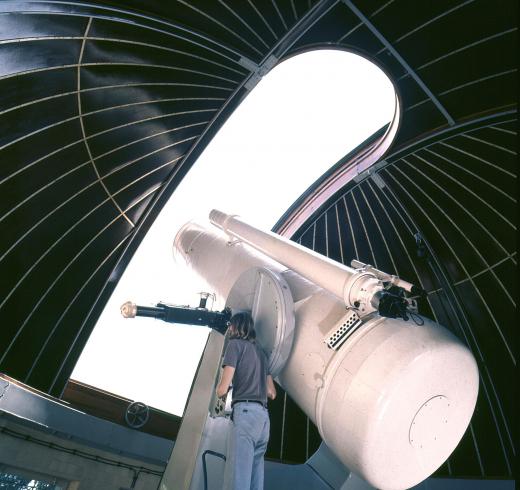What is a Telestereoscope?
 Mary McMahon
Mary McMahon
A telestereoscope is an optical device which is designed to present a three dimensional view of a distant scene, sometimes called a binocular telescope because it offers a view of distant objects through both eyes. In addition to use in optometry, telestereoscopes can also be used in astronomy observatories, and at least one telestereoscope has appeared in an art installation. The basic mechanics of the device are the same in all instances, however. A telestereoscope uses two viewing fields, rather than just one, to provide a three dimensional image to the person looking through it. The experience of using a telestereoscope is similar to that of using a three dimensional viewer, or looking at a stereoscopic photograph.
The groundwork for the telestereoscope was laid by Hermann von Helmholtz, an Austrian scientist who lived between 1821-1894. He had a background in medicine and physics, and spent a great deal of time pursuing the study of optics. He invented the opthalmoscope, a medical instrument which is used to examine the inside of the human eye. He also speculated on color vision, how humans see motion, and depth perception. The telestereoscope was an optical device which he used to further his research.

A telestereoscope takes advantage of basic human optics. The human eye interprets images with the understanding that the distance between the eyes does not change. When someone looks at things in daily life, he or she is seeing a stereoscopic, or three dimensional, image, and the eyes create a sense of depth given the two images that they are receiving. Depth perception is used as a visual cue to determine how far away from something someone is. In the case of a telestereoscope, the viewer looks through periscopes which are spaced further apart than normal human eyes. As the eyes struggle to interpret the images they are seeing, things which are far away suddenly seem very close, and the image appears almost hyper-real, as the depth is distorted.

In optics, a telestereoscope is frequently used in tests of depth perception, usually in a version with does not distort vision so much. Scientific studies of optic phenomena have also used telestereoscopes. In astronomy observation, a telestereoscope can be used to create a rich and lush image of a very distant point, although a telestereoscope is not a piece of standard observatory equipment, due to the cost. As an art installation, a telestereoscope can be used to make a statement about the world around the viewer, or to challenge conventional optical reality.
AS FEATURED ON:
AS FEATURED ON:












Discuss this Article
Post your comments